Keywords
|
| UWB, Probability of error, TH-PPM modulation, TH-BPSK modulation |
INTRODUCTION
|
| UWB is a novel technology emerging in recent years as a promising solution for high speed or low power indoor communications. Indeed, this technology offers the potential for robust communications in multipath and multiuser environments, as well as low cost and low complexity implementations. However, the performance of UWB systems is strongly dependant on the multiple accesses and used modulation techniques. |
| TH multiple access technique, where users are distinguished by their respective pulse arrival time sequences, is one of the most popular multi access techniques used for an impulse radio system [1]. The combination between time hopping (TH) and pulse position modulation (PPM) is the original modulation type proposed for UWB systems [3][4]. A performance study of this modulation in terms of BER has been mentioned in [5] with an AWGN channel. |
| Currently, TH-PPM and TH-BPSK UWB systems have the same interest despite the performance difference in terms of bit error rate (BER) especially. Analysis of TH-BPSK UWB systems was analyzed and studied in [6] [7] [8]. In [9], a performance comparison between different modulation scheme was applied. In this paper, our purpose is to provide an analytical method to evaluate the BER performance of TH-BPSK with the presence of an AWGN channel. |
| This paper is organized as follows. Section II describes the TH-BPSK UWB system model. In Section III, we elaborate an analytical approach to determine the performance of this modulation scheme and then, we validate the theoretical analysis with simulation results. In Section IV, we compare the performances of TH-BPSK and TH-PPM UWB system models using our analytical analysis. Finally, some conclusions are given in section V. |
TH-BPSK UWB SYSTEM MODEL
|
| In general, the UWB system is formed by short pulses. For the BPSK case, the information depends on the pulses polarities, if dj is the source signal and βi the BPSK signal modulation. This is presented as follows [8], |
 |
| From (1), we note that the basic pulse sign’s of TH-BPSK is modulated according to the data bit where for each user is assigned an unique time hopping random sequence. In our case, we consider a TH-BPSK-UWB system to apply our analytical approach. A typical transmitted TH-BPSK signal model is given in Fig.1 [10]. |
| This modulation type can be modelled as follows for the mth user [8], |
 |
| Where SBPSK (k) (t,i) is the signal transmitted by one user corresponding to the ith data bit and p(t) is the transmitted UWB pulse shape. Eb is the total energy of one information bit. Tf is the duration of a frame which can be subdivided into chips of duration Tc. cj (k) ? {0, 1, ..., Nh -1} is the TH sequence related to the kth source where Nh represents the number of hops and satisfies Nh Tc ≤ Tf [11]. As TH-BPSK UWB modulation is antipodal, di (k) ?{1,-1} represents the ith data bit transmitted by the kth source with the same probability. |
ANALYTICAL APPROACH FOR TH-BPSK UWB SYSTEM MODEL
|
| The performance analysis starts by the reception of the TH-BPSK system. If we consider the TH-BPSK performance for one user and one path, (2) becomes, |
 ..........(3) ..........(3) |
| If we suppose that the temporal support is disjoints, we obtain after calculation(4), |
 (4) (4) |
| With Rw = [T] p2 (t) dt represents the autocorrelation function of the transmitted signal, and determines the noise power. In the noise less case (b(t)=0), we obtain, |
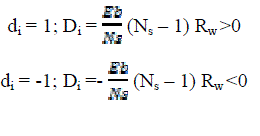 (5) (5) |
| The performance study of TH-BPSK is based on the comparison of the received sequences with the emitted ones. If we suppose that the di are equiprobably distributed, we have then, |
 ..........(6) ..........(6) |
 (7) (7) |
| To determine the autocorrelation function, we consider the Gaussian impulse relation as follows, |
 |
| Consequently, the autocorrelation function Rw becomes, |
 |
| By following this way and replacing Rw(0) by its expression, we obtain the equation (9), which represents the performance of TH-BPSK UWB system model for one user and one path, |
 ...........(8) ...........(8) |
| Which Eb represents the bit energy, N0 is the power noise and Q is the Marcum function. |
| Fig. 2 shows BER curve of TH-BPSK system in theory case versus simulation with the MATLAB tool. We note, from this figure, that the theoretical and simulated results are approximately similar. This validates the approach using our new analytical analysis. |
PERFORMANCE COMPARISON BETWEEN THE TH-BPSK AND TH-PPM UWB SYSTEM MODEL
|
A.TH-PPM UWB SYSTEM MODEL
|
| TH.PPM UWB system model is the very popular scheme because it depends to the pulse that will be sent early or late relatively to the data transmitted. In [11], PPM is defined as a modulation type that introduces a shift (δ) to distinguish between the pulses related to the bit “0” and the bit “1”. |
| A typical UWB TH-PPM waveform can be modelled as follows, |
 |
| Where wtr is the transmitted pulse shape of duration Tp, Ts is the symbol duration. Tf is the frame period. Ns is the chips number with duration Tc and di ?{0,1} is the data bit transmitted. |
| After calculation of the probability of error as the same method as TH-BPSK UWB system model, we obtain the equation (10) related to the performance of TH-PPM UWB system model found in [1], |
 |
| Fig. 3 shows the performance of TH-PPM UWB system model found in the theoretical case from (10) compared to the simulation results. |
B.PERFORMANCE COMPARISON
|
| In this part, we compare the performance between the TH-BPSK and TH-PPM UWB system models with the results found in (8) and (10). This is given in Fig. 4, which represents the comparison performance between TH-BPSK and TH-PPM system models with our analytical approach. |
| From this figure, we notice that the TH-BPSK model is better than the TH-PPM for all values of SNR. This further validates our analytical approach, as confirmed by the previous studies in this domain [7]. |
| While TH-BPSK is antipodal, this modulation scheme agrees with properties of UWB system which consequently is better than TH-PPM that’s an orthogonal signal. We can conclude that TH-BPSK is a good choice for UWB application, but it doesn’t mean that TH-PPM is not usable. It can be used in many other applications. Additionally, BPSK is able to delete spectral lines which, if existing, could interfere with conventional radio systems. The TH-BPSK receiver detects the two signal polarities (1 and -1). But for the TH-PPM case, we have only one phase to detect which may provide more error with noise. |
CONCLUSION
|
| In this paper we have proposed and analyzed bit error probability performance of TH-BPSK UWB multiple access communication in AWGN channel. We have provided a characteristics mathematical method to calculate the BER. Then, we validate our analytical approach by simulation and comparing with the results found for the TH-PPM case. |
| From this study we can conclude that the UWB TH-BPSK system model outperforms UWB TH-PPM for all values of SNR. This result confirms other results find by other authors using different analytical approach. We can consequently choose the TH-BPSK model as the suitable scheme for UWB communication system design. A natural extension of this work is to include propagation over multipath channels. The proposed analytical approach presented in this article can be extended further to other UWB modulation schemes like TH-OOK. It may be possible in future research to study the performance of TH M-ary Phase Shifting Keying (TH-MBPSK) and M-ary pulse position modulation (TH-MPPM). |
Figures at a glance
|
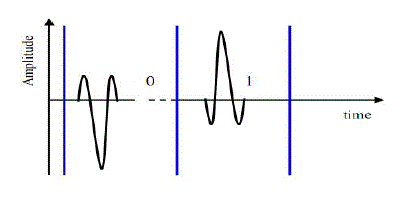 |
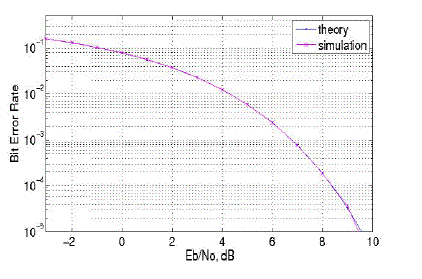 |
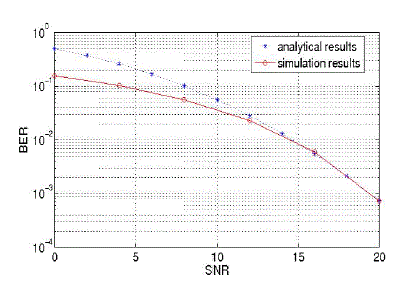 |
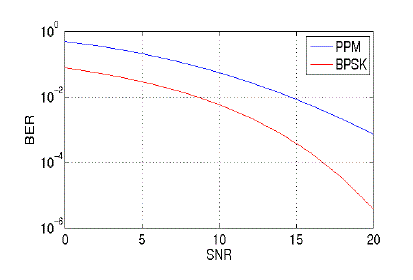 |
| Figure 1 |
Figure 2 |
Figure 3 |
Figure 4 |
|
References
|
- M. Hizem and R. Bouallegue, “analytical probability of error in TH-PPM and TH-PAM Ultra Wideband Systems,” IEEE ICECS on Electronics, Circuits and Systems, pp. 930-933, September 2008.
- P.Saad, C.Botteron, R.Merz, and P.-A. Farine, “ Performance comparison of UWB impulse-based multiple access schemes in indoor multipath channels,” in proc. 5th workshop on Positioning, Navigation and Communication (WPCN’08), Hannover, Germany, pp. 89-94, March 2008.
- R.A.Scholtz, “Multiple access with time-hopping impulse modulation ,” IEEE Military Communications conf., pp. 11-14, 1993.
- M.Z.Win and R.A.Scholtz, “Impulse radio: How it works,” IEEE commun. Lett., vol. 2, pp.36-38, Feb. 1998.
- A.Taha and K.M.Chugg, “A theoretical study on the effects of interferenceon UWB multiple access impulse radio,” in Proc. Asilomar Conf. Signals, Computers, pp. 728-732, Nov. 2002.
- B.Hu and N.C.Beaulieu, “Accurate evaluation of multiple access performance in TH-PPM and TH-BPSK UWB systems,” IEEE Trans. Commun., vol. 52, no. 10, pp. 1758-1766, oct. 2004.
- Z.Chen, Y.P.Zhang, A.Q.Hu, and T.-S.Ng, “Bit-error-rate analysis of UWB radio using BPSK modulation over inter-chip radio channels for wireless chip area networks,” IEEE Transanctions on Wireless Communications, vol.8, no. 5 , may 2009.
- G.Durisi and S.Benedetto, “ Performance evaluation and comparison of different modulation schemes for UWB multi-access systems,” IEEE Ibt. Conf. Communications, Anchorage, AK, pp. 2187-2191, May 2003.
- H.Q.Quach, “Narrowband Interference Detection and Mitigation for Indoor Ultra-Wideband Communication Syatems,” Ph.D, dissertation, Dept. Elect. Eng., Saskatchewan Univ., Canada 2006.
- I.Hosseini and N.C. Beaulieu, “ Bit-error rate of TH-BPSK UWB receivers in multiuser interference,” IEEE Transactions on Wireless Communications, vol. 8, no. 10, October,2009.
- G.Durisi and S.Benedetto, “ Performance evaluation of TH-PPM UWB systems in the presence of multiuser interference,” IEEE Commun. Lett.,vol.7 pp. 224-226, May 2003.
|